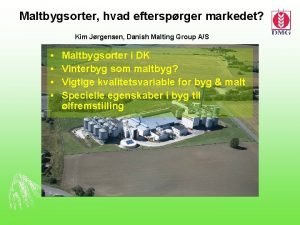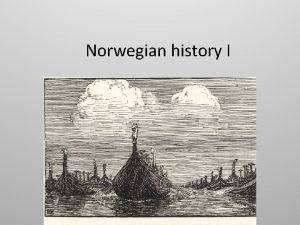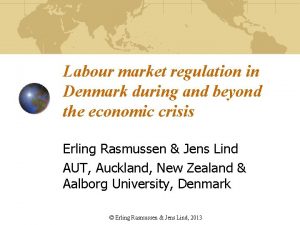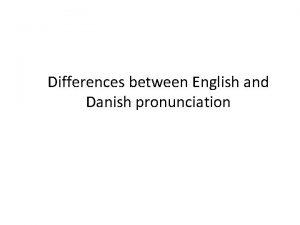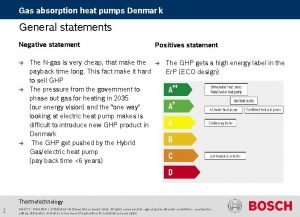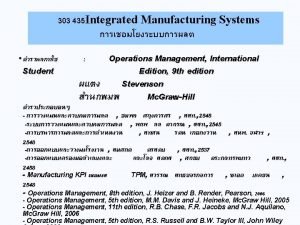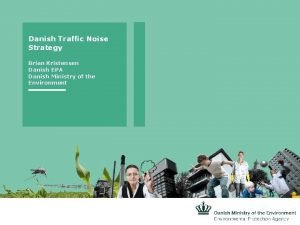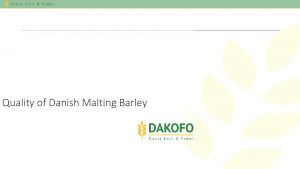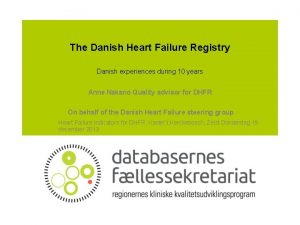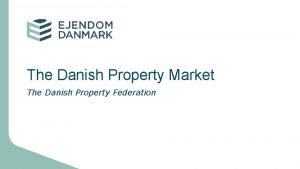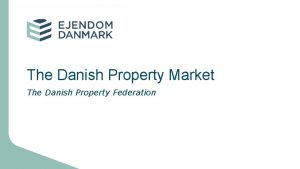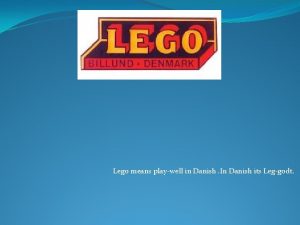Organizing Eldercare The Danish Case in a Comparative













- Slides: 13

Organizing Eldercare The Danish Case in a Comparative Perspective Morten Balle Hansen, Professor, Ph. D Department of Political Science, Aalborg University Denmark mbh@dps. aau. dk No. 1

Outline 1. Introduction 2. Some Global Trends 3. Global variation in organizing eldercare 4. The Danish (Nordic) Case 5. Key facts Danish Long Term Care 6. Discussion: Advantages and disadvantages Danish system No. 2

Some Global Trends • From a purely demographical point of view, since the 1970 s, the need for elder service on a global scale has grown and will continue to grow over the next decades • The percentage of the world’s population which is 60 years old or older has increased from 8 % in 1970 to 10% in 2000 and is expected to reach 15 % in 2025 and 22 % in 2050 (Mirkin & Weinberger 2001, 37 -38) • Claim: How a society choose to organize its eldercare increasingly determines its success in the global economy No. 3

Global variations in Organizing Eldercare I Family and state • Traditionally the family has taking care of the elderly • In all countries the family and informal social networks continues to play a significant role • In many countries however – and increasingly in the past decades – the state has taken over a lot of this responsibility – especially in the Northern part of Europe • This is also shown in judicial terms: • In the Nordic countries and the Netherlands the state is legally responsible for taking care of the elderly • In the southern part of Europe the family (defined in various ways) is legally responsible • The change tends to covary with women participation rates in the labor market No. 4

Global variations in Organizing Eldercare II Financing eldercare: Who pays? • Taxes (Denmark) • Taxes and user payment: (Other Nordic countries, Austria, etc. ) • Insurance (public) and user payment: (Netherlands, Germany, etc. ) • Either taxes (low income groups) or private insurance (high income groups) and user payment: (France, USA, etc. ) • Family or non-profit (e. g. church) charity organizations No. 5

Global variations in Organizing Eldercare III Organizing eldercare: Who controls and organizes the eldercare? • Public: Municipalities (Denmark, other Nordic countries, UK) • Public: Local health boards (Ireland) • Public: representatives for AWBZ (Netherlands) • Public: other kinds of public sector organizing • Public and private: (Belgium and France) • Non-profit organizations or family: (Greece) No. 6

Global variations in Organizing Eldercare IV Supply: Who are the primary suppliers of eldercare? • Public municipalities and some private and/or Non-profit providers: (Denmark, other Nordic countries, UK) • Non-profit providers and some private companies: (Netherlands, Germany, Italy, etc. ) No. 7

Summing up on global (European) variations as related to Denmark Financing eldercare: Who pays? • Denmark is unique in the sense that almost all costs are financed by tax payers Organizing eldercare: Who controls and organizes the eldercare? • Denmark, other Nordic countries and UK relies heavily on local government administration to organize and control Supply: Who are the primary suppliers of eldercare? • Denmark, other Nordic countries and UK relies on local government supply, but increasingly private providers as well No. 8

The Danish Long-Term Care System The Danish long-term care (LTC) system for the elderly and people with disability, including home-help services, is a universal system. • The Danish Central government is responsible for determining the overall principles underpinning the longterm care system. • Local authorities are responsible for the delivery of LTC services, make and implement LTC policy and decide how LTC resources are allocated • No. 9

Key facts Danish Long Term Care • Approx. 16. 1% of the Danish population is aged over 65 (OECD average 15%) while 4. 1% of the population is aged over 80 (OECD average 4%) • Denmark spent 2 % of its GDP on health related long term care in 2007, of which 1, 8% was publicly funded. • Denmark spent 1, 2% GDP on home long-term care and 0, 8% on institutional long-term care in 2007 • In 2007 there where 9. 5 formal long-term care workers per 1000 population over the age of 65, above the average OECD of 6. 1 workers • In 2008, there were 14. 5 long-term care beds per 1, 000 population aged 65 years old and over, substantially lower than OECD-average of 44. 5 beds (OECD Health Data, 2010) No. 10

Benefits and Eligibility Criteria • The Danish LTC system provides comprehensive coverage for a widerange of social services, including home adaptation, assistive devices and home help • One of the main aims of the social services for elderly and disabled people is to ensure that they can manage in their own homes. • In cases where elderly or disabled people cannot manage on their own, they can move to residential care homes and sheltered homes • Eligibility is based on a needs’ assessment performed by the local authority • Eligible individuals may receive a cash benefit in order to employ necessary assistance • In order to qualify for this allowance, an individual must meet a given level of need No. 11

Discussion of the Danish system I Advantages: • Sons and daughters of elderly people are able to work full time far away from their parents knowing that there is a reasonably well functioning system to take care of them • The municipalities has continuously taken professionally good care of improving the LTC system – both in terms of efficiency – delivering value for money – and in terms of quality – improving the quality of eldercare • Equality: All elderly, no matter of previous income in work life, are given a relatively high quality of eldercare • Public debate: Since we are all dependent of this system, public debate tend to focus on how a decent level a eldercare quality looks like No. 12

Discussion of the Danish system II Disadvantages: • The Danish Long Term Care system is very expensive and imply a high administrative burden on taxpayers – Denmark has for many years been in top 2 -3 in terms of incom tax level • The paternalistic features of the system, defining one societal acceptable standard of eldercare for all elderly, could be seen as too collectivistic and against a more individual approach to life as elder citizens • Since the elderly has increasing electoral power, the system may tend to enhance too much money spend on the elderly compared to other groups in society No. 13
 National eldercare locator
National eldercare locator Family eldercare
Family eldercare Best worst and average case
Best worst and average case Danish malting group
Danish malting group Danish alphabet sounds
Danish alphabet sounds Danish language
Danish language Danish labour supply
Danish labour supply Setting of beowolf
Setting of beowolf Danish education system vs american
Danish education system vs american Danish alphabet sounds
Danish alphabet sounds Danish labour supply
Danish labour supply Danish diaphragm pump
Danish diaphragm pump Danish pastry adalah
Danish pastry adalah Danske maritime fond
Danske maritime fond



